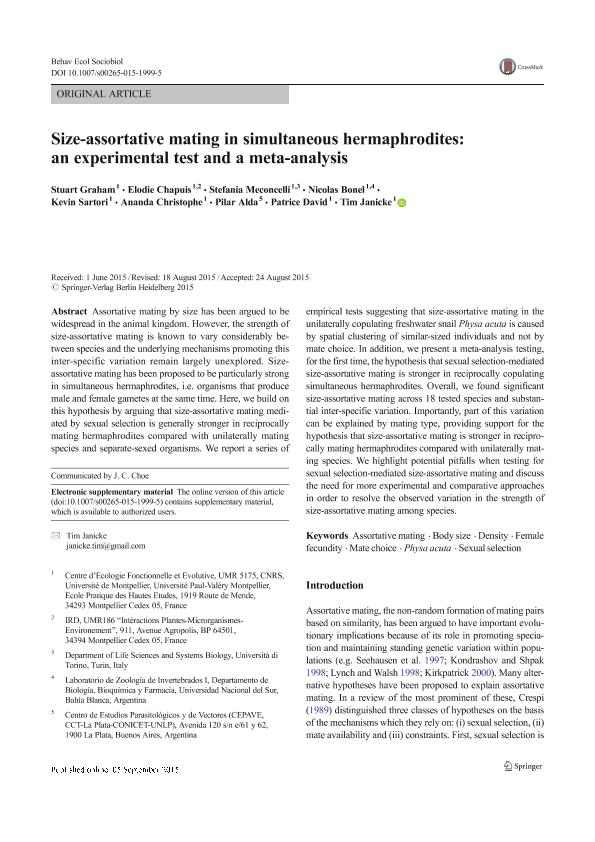Mostrar el registro sencillo del ítem
dc.contributor.author
Graham, Stuart
dc.contributor.author
Chapuis, Elodie
dc.contributor.author
Meconcelli, Stefania
dc.contributor.author
Bonel, Nicolás

dc.contributor.author
Sartori, Kevin
dc.contributor.author
Christophe, Ananda
dc.contributor.author
Alda, Maria del Pilar

dc.contributor.author
Patrice David
dc.contributor.author
Janicke, Tim

dc.date.available
2018-05-14T17:25:28Z
dc.date.issued
2015-11-05
dc.identifier.citation
Graham, Stuart; Chapuis, Elodie; Meconcelli, Stefania; Bonel, Nicolás; Sartori, Kevin; et al.; Size-assortative mating in simultaneous hermaphrodites: an experimental test and a meta-analysis; Springer; Behavioral Ecology And Sociobiology; 69; 11; 5-11-2015; 1867-1878
dc.identifier.issn
0340-5443
dc.identifier.uri
http://hdl.handle.net/11336/45090
dc.description.abstract
Assortative mating by size has been argued to be widespread in the animal kingdom. However, the strength of size-assortative mating is known to vary considerably between species and the underlying mechanisms promoting this inter-specific variation remain largely unexplored. Size-assortative mating has been proposed to be particularly strong in simultaneous hermaphrodites, i.e. organisms that produce male and female gametes at the same time. Here, we build on this hypothesis by arguing that size-assortative mating mediated by sexual selection is generally stronger in reciprocally mating hermaphrodites compared with unilaterally mating species and separate-sexed organisms. We report a series of empirical tests suggesting that size-assortative mating in the unilaterally copulating freshwater snail Physa acuta is caused by spatial clustering of similar-sized individuals and not by mate choice. In addition, we present a meta-analysis testing, for the first time, the hypothesis that sexual selection-mediated size-assortative mating is stronger in reciprocally copulating simultaneous hermaphrodites. Overall, we found significant size-assortative mating across 18 tested species and substantial inter-specific variation. Importantly, part of this variation can be explained by mating type, providing support for the hypothesis that size-assortative mating is stronger in reciprocally mating hermaphrodites compared with unilaterally mating species. We highlight potential pitfalls when testing for sexual selection-mediated size-assortative mating and discuss the need for more experimental and comparative approaches in order to resolve the observed variation in the strength of size-assortative mating among species.
dc.format
application/pdf
dc.language.iso
eng
dc.publisher
Springer

dc.rights
info:eu-repo/semantics/openAccess
dc.rights
Atribución-NoComercial-CompartirIgual 2.5 Argentina (CC BY-NC-SA 2.5 AR)
dc.rights.uri
https://creativecommons.org/licenses/by-nc-sa/2.5/ar/
dc.subject
Assortative Mating
dc.subject
Body Size
dc.subject
Density
dc.subject
Female Fecundity
dc.subject
Mate Choice
dc.subject
Physa Acuta
dc.subject
Sexual Selection
dc.subject.classification
Otras Ciencias Biológicas

dc.subject.classification
Ciencias Biológicas

dc.subject.classification
CIENCIAS NATURALES Y EXACTAS

dc.title
Size-assortative mating in simultaneous hermaphrodites: an experimental test and a meta-analysis
dc.type
info:eu-repo/semantics/article
dc.type
info:ar-repo/semantics/artículo
dc.type
info:eu-repo/semantics/publishedVersion
dc.date.updated
2018-05-04T21:08:23Z
dc.identifier.eissn
1432-0762
dc.journal.volume
69
dc.journal.number
11
dc.journal.pagination
1867-1878
dc.journal.pais
Alemania

dc.journal.ciudad
Berlín
dc.description.fil
Fil: Graham, Stuart. Université de Montpellier. Centre d’Ecologie Fonctionnelle et Evolutive; Francia. Université Paul-Valéry Montpellier; Francia. Centre National de la Recherche Scientifique; Francia
dc.description.fil
Fil: Chapuis, Elodie. Université de Montpellier. Centre d’Ecologie Fonctionnelle et Evolutive; Francia. Centre National de la Recherche Scientifique; Francia. Institut de Recherche pour le Développement,. Intéractions Plantes-Microrganismes-Environement; Francia. Université Paul-Valéry Montpellier; Francia
dc.description.fil
Fil: Meconcelli, Stefania. Université de Montpellier. Centre d’Ecologie Fonctionnelle et Evolutive; Francia. Centre National de la Recherche Scientifique; Francia. Università di Torino; Italia
dc.description.fil
Fil: Bonel, Nicolás. Consejo Nacional de Investigaciones Científicas y Técnicas. Centro Científico Tecnológico Conicet - Bahía Blanca; Argentina. Universidad Nacional del Sur. Departamento de Biología, Bioquímica y Farmacia. Laboratorio de Zoología de Invertebrados I; Argentina. Université de Montpellier. Centre d’Ecologie Fonctionnelle et Evolutive; Francia. Université Paul-Valéry Montpellier; Francia
dc.description.fil
Fil: Sartori, Kevin. Université de Montpellier. Centre d’Ecologie Fonctionnelle et Evolutive; Francia. Centre National de la Recherche Scientifique; Francia. Université Paul-Valéry Montpellier; Francia
dc.description.fil
Fil: Christophe, Ananda. Université de Montpellier. Centre d’Ecologie Fonctionnelle et Evolutive; Francia. Centre National de la Recherche Scientifique; Francia. Université Paul-Valéry Montpellier; Francia
dc.description.fil
Fil: Alda, Maria del Pilar. Consejo Nacional de Investigaciones Científicas y Técnicas. Centro Científico Tecnológico Conicet - La Plata. Centro de Estudios Parasitológicos y de Vectores. Universidad Nacional de La Plata. Facultad de Ciencias Naturales y Museo. Centro de Estudios Parasitológicos y de Vectores; Argentina
dc.description.fil
Fil: Patrice David. Université de Montpellier. Centre d’Ecologie Fonctionnelle et Evolutive; Francia. Centre National de la Recherche Scientifique; Francia. Université Paul-Valéry Montpellier; Francia
dc.description.fil
Fil: Janicke, Tim. Université de Montpellier. Centre d’Ecologie Fonctionnelle et Evolutive; Francia. Centre National de la Recherche Scientifique; Francia. Université Paul-Valéry Montpellier; Francia
dc.journal.title
Behavioral Ecology And Sociobiology

dc.relation.alternativeid
info:eu-repo/semantics/altIdentifier/url/https://link.springer.com/article/10.1007/s00265-015-1999-5
dc.relation.alternativeid
info:eu-repo/semantics/altIdentifier/doi/http://dx.doi.org/10.1007/s00265-015-1999-5
Archivos asociados
